

Graphing made easy: Practical tools for school psychologists. Graphing made easy: Practical tools for school psychologists James McDougal Karrie Clark Jacklyn Wilson State University of New York at Oswego Academic Monitoring: Templates for CBM, DIBELS™, and BEA.

Behavioral Monitoring: Templates for DBRC, Time on Task, Frequency Monitoring and BOSS. Behavior Monitoring Forms: Forms to facilitate data collection: Narrative ABC Record, Behavioral Scatterplot, Teacher Behavior Log, Interval Sampling Recording Form, Daily Behavior Report Card and Monitoring Summary Sheet. Create RTI Graphs and Charts Free. Response to Intervention. ChartDog Chart Generator: On-Line Manual. ChartDog is a web-based application that allows you to create progress-monitoring graphs.
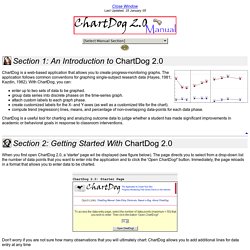
The application follows common conventions for graphing single-subject research data (Hayes, 1981; Kazdin, 1982). With ChartDog, you can: enter up to two sets of data to be graphed. Group data series into discrete phases on the time-series graph. Attach custom labels to each graph phase. ChartDog is a useful tool for charting and analyzing outcome data to judge whether a student has made significant improvements in academic or behavioral goals in response to classroom interventions. When you first open ChartDog 2.0, a 'starter' page wil be displayed (see figure below). Don't worry if you are not sure how many observations that you will ultimately chart: ChartDog allows you to add additional lines for data entry at any time ChartDog gives you the ability to customize your data graph to suit your own needs.
Chart Title. Y-axis Title. Show Data Values. Entering Dates of Observations. The dog icons. ChartDog 2.0: The School-Based Application to Create On-Line Time-Series Charts. Free Online bar graph maker. Progress monitoring - MindWing Concepts, Inc. Fourth Grade. [en Español] By the end of fourth grade your child should be able to do the following: Listening Listen to and understand information presented by othersForm opinions based on evidenceListen for specific purposes Speaking Use words appropriately in conversationUse language effectively for a variety of purposesUnderstand some figurative language (e.g., "the forest stretched across…")Participate in group discussionsGive accurate directions to othersSummarize and restate ideasOrganize information for clarityUse subject area information and vocabulary (e.g., social studies) for learningMake effective oral presentations Reading Writing Write effective stories and explanations, including several paragraphs about the same topicDevelop a plan for writing, including a beginning, middle, and endOrganize writing to convey a central ideaEdit final copies for grammar, punctuation, and spelling.
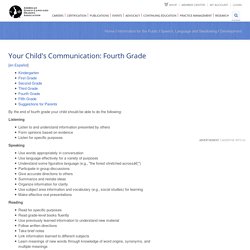
Third Grade. [en Español] By the end of third grade your child should be able to do the following: Listening Listen attentively in group situationsUnderstand grade-level material Speaking Speak clearly with an appropriate voiceAsk and respond to questionsParticipate in conversations and group discussionsUse subject-related vocabularyStay on topic, use appropriate eye contact, and take turns in conversationSummarize a story accuratelyExplain what has been learned Reading Demonstrate full mastery of basic phonicsUse word analysis skills when readingUse clues from language content and structure to help understand what is readPredict and justify what will happen next in stories and compare and contrast storiesAsk and answer questions regarding reading materialUse acquired information to learn about new topicsRead grade-level books fluently (fiction and nonfiction)Reread and correct errors when necessary Writing.
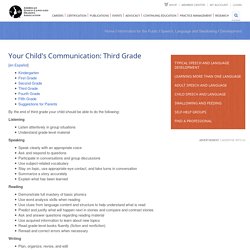
Qualitative Reading Inventory, 5/E - Lauren Leslie & JoAnne Schudt Caldwell. Contents Preface Section 1 Description of the Qualitative Inventory Section 2 A Research Perspective Reading Acquisition: A Developmental Process Factors Related to Comprehension Factors Related to Word Identification Factors Related to Use of an Informal Reading Inventory Section 3 Information Provided by the Qualitative Reading Inventory Finding Reading Levels Determining Reader Strengths and Needs Documenting Growth and Change Questions Regarding the Validity and Reliability of QRI-5 Section 4 Uses of Qualitative Reading Inventory 5-The Examiner as a Reflective Decision Maker.
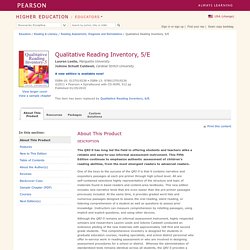
Edmonton Narrative Norms Instrument (ENNI) - Faculty of Rehabilitation Medicine - University of Alberta. Phyllis Schneider1, University of Alberta Rita Vis Dubé, Calgary Denyse Hayward, University of Alberta The ENNI was developed with the assistance of a grant from theChildren's Health Foundation of Northern Alberta.
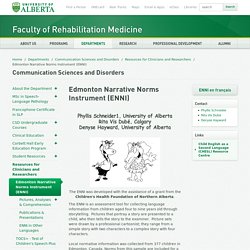
The ENNI is an assessment tool for collecting language information from children aged four to nine years old through storytelling. Pictures that portray a story are presented to a child, who then tells the story to the examiner. Picture sets were drawn by a professional cartoonist; they range from a simple story with two characters to a complex story with four characters. Local normative information was collected from 377 children in Edmonton, Canada. The ENNI is copyrighted, including the pictures and all other materials. When citing this website, please use the following format: Schneider, P., Dubé, R. ENNI Demonstration The following is a demonstration of story A1. Language Assessments for Pre-K.